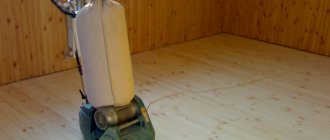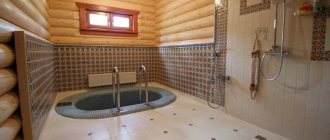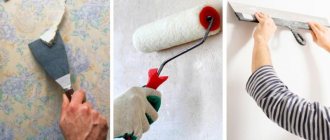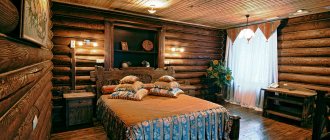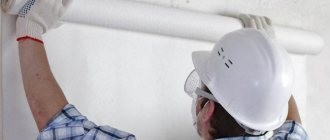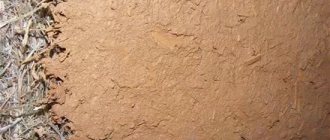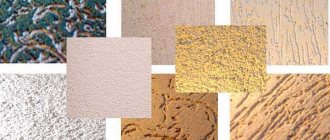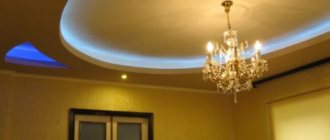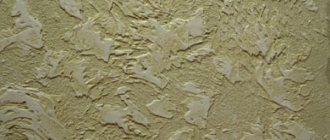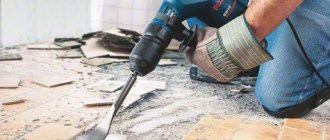Let's start this material by defining the concept of what a self-leveling mixture is.
A self-leveling mixture is a physical-chemical system.
It is based on compounds of aluminous and Portland cement, polymer additives, quartz sand and surfactants.
option when you use a self-leveling mixture is called self-leveling floor . The second name of the method is screed made from a self-leveling mixture.
Classification by composition and purpose
They differ in composition and functional purpose.
The composition is:
- cement;
- gypsum (anhydrite);
- magnesian.
Cement ones are more expensive, but they can be used in rooms with any humidity, unlike gypsum, the use of which is recommended only in dry rooms.
Magnesium is corrosive, so all metal floor elements must be insulated before applying a solution based on this base.
According to their functional purpose, mixtures are divided into:
- rough leveling;
- final alignment;
- special.
Rough leveling is used in conditions where the subfloor has serious defects and unevenness.
Final leveling is used if the base has no visible defects and is sufficiently level.
Special ones are usually used to eliminate serious defects in the form of cracks and chips.
Features of successful pouring of self-leveling floors
In order for the construction of a flat floor surface to be carried out efficiently, it is important to understand certain nuances of this technology.
- First of all, all technological processes must be performed together with an assistant. This will significantly speed up the work and allow you to achieve a good result.
- It is very important to have the proper tools and clothing when doing DIY work. So, the presence of needle-shaped paint shoes will allow you to move directly over the fresh construction composition without any problems, without leaving any traces behind.
- As with any construction process, you need to take care of personal protective equipment, in particular rubberized gloves, since the compounds used during repairs are quite aggressive and can corrode the skin.
- The microclimate of the room being repaired has a particular influence on the initial result. Thus, the optimal temperature regime should be no lower than +10°C but not higher than +30°C, while air humidity should not exceed 60%.
- Upon completion of the filling work, the surface of the set floor is covered with a polyethylene film or special foil material. This will protect the base from various defects and loss of strength.
As you can see, leveling the floor with a self-leveling mixture is a process that requires certain skills and the proper tools and, of course, the desire to work. However, if you follow all the recommendations and technologies for applying self-leveling floors, the final result will please the homeowner for a fairly long period of time, which is very important for high-quality repairs.
Preparing for work
So, first, make sure once again that you have done all the work to prepare the base of the floor. Most often, concrete and wood serve as the base for self-leveling floors .
You need to double-check that all debris has been removed and any cracks or other openings have been sealed. This is true for both a cement base and a wood base.
Let us note an important point: using a self-leveling floor in the case of a wooden base is quite risky .
Under the weight of the mixture, the wood can become deformed and crack, so it is better to use other leveling options for a wooden base.
It is better to lay linoleum on a wooden floor. Read more about this in the article “How to lay linoleum on a wooden floor: installation tips, selection and preparation”
If you nevertheless decide to use a self-leveling floor to level a wooden base, then the process of use itself will be completely similar to working with a concrete base.
Before starting pouring, it is advisable to treat the floor with a primer in one, preferably two layers.
It is advisable to finish the priming process in the evening so that you can start pouring the next morning. Primer drying time is from 5 to 15 hours. Now let's move on to the next stage.
How to choose a mixture for self-leveling floors
An important point in choosing self-leveling mixtures will be based not only on the manufacturer. You shouldn’t chase popular names, as even outsiders are starting to crowd them out. The main thing in them is not the content of special components, but the correct mixing technology.
First of all, pay attention to those manufacturers who have more detailed mixing instructions on their packaging. Please also keep in mind that self-leveling mixtures can be made either on a cement base or on a gypsum base. Cement-based mixtures will be more fragile and have a decent weight, but they are not afraid of moisture. Gypsum-based mixtures are more elastic and lightweight, they are susceptible to moisture.
When choosing a mixture, you need to consider the flooring, namely what type of flooring you are going to install. If it is linoleum with a foam base, marmoleum, or ceramic tiles, then you can simply fill in a leveling layer. When laying parquet or cork flooring, you will need a top leveling layer of self-leveling mixtures.
The ratio of cement and sand in floor screed mortar
Remember that the shelf life of self-leveling mixtures is from six months to one year. Bags are often marked with a tick in the month box, which must be subtracted from the production date, since it is unknown whether the mixture was made at the beginning or at the end of the month. If the expiration date has passed, then you should not buy the mixture under any persuasion of the seller.
Preparing the solution and mixing
The first and basic rule is to read the instructions on the packaging. The instructions clearly state the required proportions, and there is no need for amateur efforts .
It is impossible to prepare the solution ahead of time, since the hardening time is short, about 30-40 minutes. It is convenient to do the work together, one person prepares the solution, the second pours it.
The solution preparation procedure consists of three stages:
- Water is poured into a container with a volume of 40-60 liters.
The amount of water is calculated based on the instructions for use of the mixture.
- The mixture is poured into a container with water.
- The solution is mixed manually or using a drill (construction mixer) with the necessary attachment.
Work occurs exclusively at low speeds.
You need to stir until a homogeneous mass appears.
Necessary conditions for creating a high-quality solution:
- The mixture is poured into water, rather than water being poured into the poured mixture;
- Do not add water to the prepared solution.
Initially, following the instructions, calculate how much water is needed per volume.
Advantages of self-leveling floors
Self-leveling mixtures are widely used not only in private, but also in industrial construction.
Mineral mixtures have a wider range of applications, as they are perfect for leveling the floor for further finishing. Their binding component is cement or gypsum. Cement mixtures can be used to screed floors in any room. In this case, the layer thickness varies from 3 to 30 mm, although some solutions are poured in a thicker layer (up to 50-60 mm). Since the thickness of the screed is small, cement-based compositions dry quickly enough, which reduces the time for finishing work.
The great popularity of such solutions is due to their following advantages:
Scheme for determining floor area.
- environmental safety - the mixtures contain only components that are safe for the human body and the environment, so they can be used to screed in any room, be it a hallway, kitchen, bedroom or children's room;
- light weight allows you to reduce the load on the supporting structure of the house, which will have a positive effect on its service life;
- fire resistance - self-leveling mixtures are absolutely non-flammable, so they can be used even in rooms with a high level of fire safety;
- simplicity of preparation and pouring allows you to cope with all the work yourself, that is, without the involvement of a construction team;
- small thickness of the screed - the minimum thickness of the fill is 3 mm, which is especially important for apartments with low ceilings;
- wide range of products - in the modern building materials market, leveling mixtures are presented by both domestic and foreign companies, so you can easily choose the most suitable composition for a particular case.
The disadvantages of self-leveling mixtures include their low heat and sound insulation properties, which is due to the small thickness of the fill, and their high cost compared to conventional cement-sand mortars.
Pouring the solution onto the prepared base
So, we are ready to start pouring the solution. Depending on the quality of the base, you use either a coarse leveling mixture (the grain size of the dry fraction of the mixture is more than 1.5 mm) or a final leveling mixture (the grain size of the dry fraction is 0.6-0.8 mm).
Necessary condition: the solution should not harden before pouring the next strip. One fill strip should overlap the other.
Sometimes both mixtures are used, the rough leveling solution is poured first, and after drying the final leveling mixture is used . This method allows you to achieve a perfectly even floor covering, but from a financial point of view it is extremely unprofitable.
We select the wall farthest from the door, and start pouring the mortar onto the floor from there, marking a conditional fill strip 30-70 cm wide.
The process itself is quite simple:
- The container with the prepared solution is turned over.
- It pours out onto the floor.
- Use a spatula or rule to level it out.
- Then roll it over the surface with a needle roller, removing air from the solution.
Thus, sequential filling occurs from the far wall to the door. The size of the roller needles should be larger than the solution layer . Do not forget that the mixture hardens quickly and you should not hesitate, so it is very important to do the work quickly and accurately.
One person pours the solution, and the second is already preparing the next portion. It is not advisable to stand on a flooded floor; if you still need to walk, use paint shoes; they fit on your shoes.
The time for complete drying depends on humidity and air temperature and the composition of the solution itself; in most cases, the process takes about 5 days. It is not recommended to artificially speed up the drying process.
Sequence of work
Before starting work, it is necessary to prepare the mortar:
Building mixture
- To do this, mix water and dry building mixture in the required proportions in a convenient, clean container.
- The composition is mixed with a construction mixer or an electric drill with a specially designed nozzle.
- Kneading occurs until the composition is completely homogeneous without air bubbles or lumps of dry material.
- The resulting solution must be processed no later than 40 minutes, so the work must be completed fairly quickly. Otherwise, the mixture will set and further use will be impossible.
- Filling begins from the farthest corner of the room, gradually moving to the exit.
- The solution is not poured all at once, but in portions from one edge of the wall to the other, up to half a meter wide. Each portion is evenly leveled over the floor surface using a wide construction spatula. Particular attention should be paid to hard-to-reach places: under the stairs, around the radiator and in the corners of the room.
- After the entire base of the floor is covered with a self-leveling compound, final leveling is performed with a special roller with spikes. This operation is performed to get rid of air bubbles, thereby improving the adhesive properties of the floor.
Prices
In conclusion, let's say a few words about prices. The market is quite wide and there are many offers from manufacturers .
And, naturally, each of the manufacturers assures the exclusivity of their products. As a rule, the price for final leveling mixtures is higher than for rough mixtures.
In general, using the mixture is a rather expensive option . To purchase one bag weighing 25 kg you will pay a minimum of 250 rubles.
The use of a screed is justified, provided that the difference in floor height is no more than 30 mm. If the difference is greater, then less expensive methods are used.
Pigments are usually added to industrial mixtures to color the mixtures in certain colors.
Let's look at a few examples of manufacturers with prices.
Knauf
Used mainly for rough leveling. Examples:
- self-leveling gypsum floor KNAUF Boden25 40kg – from 350 rubles;
- thin-layer gypsum screed KNAUF Boden15 25 kg - from 500 rubles;
- self-leveling gypsum floor KNAUF Boden30 40kg – from 450 rubles.
Vetonit
Used mainly for rough leveling. One of the top sellers. On average, prices for Vetonit mixtures are higher than for mixtures from other manufacturers. Examples:
- self-leveling floor Vetonit 3000 25 kg – from 600 rubles;
- self-leveling floor Vetonit 5000 25 kg – from 500 rubles.
Bolars
They are used mainly for rough leveling, although there are also finishing mixtures.
Inferior in popularity to the two previous brands. Examples:
- SV-1010 25kg – from 350 rubles;
- SV-1030 25kg – from 270 rubles;
- SV-210 PROFI 25 kg – from 350 rubles.
Ceresite (moment)
This is one of the oldest brands on the market. A very wide selection of products for different purposes. Examples:
- Ceresit CH 178 - from 300 rubles;
- Ceresit CH 72 - from 600 rubles;
- Ceresite CH 86 – from 1200 rubles.
Horizon
The company offers a wide range and allows you to select mixtures for any floor covering. Examples:
- Horizon CH 30 25kg – from 240 rubles;
- Horizon 2 25 kg – from 400 rubles.
Volma
Products under this brand offer a very wide selection at low prices. Examples:
- Volma Level Express 20 kg – from 250 rubles;
- Volma Rough leveler 25 kg – from 200 rubles.
If you are not doing the repairs yourself, then you also need to pay for the work of the performers - from 250 rubles per square meter.
Useful video on how to fill a floor with your own hands
Viewed times: 17,500
Great article 5
Author's rating
Author of the article
Oleg Grishin
Flooring specialist with 10 years of experience. Oleg has something to share with our readers
Articles written
105
- Even more interesting:
- Characteristics of polymer self-leveling floor
- How to fill a self-leveling floor with your own hands
- Self-leveling floors - types and characteristics
Types of self-leveling mixtures
According to their properties, self-leveling mixtures are divided into:
- Basic, used for rough leveling the floor. With their help, you can seal up bumps, cracks and potholes in the base. The layer of such screed can be up to 6 cm.
- Finishing, used for the final leveling of an already prepared base that does not have major defects. The thickness of the screed with this mixture is from 2 to 5 mm. It dries within a few hours and has a flat and smooth surface.
There are special mixtures on sale:
- Quick-drying, allowing you to minimize the waiting time for the screed to dry - only 2-3 hours. However, such a screed requires reinforcement to avoid cracking.
- Mixtures with increased strength, used for leveling individual sections of the floor. Good adhesion to the base and high strength allow this mixture to be used for leveling wooden floors.
Based on materials, the following types of self-leveling mixtures can be distinguished:
Technical characteristics of leveling mixtures for floors.
- Cement based. Advantages of cement-acrylic mixtures: good adhesion, strength, frost resistance, the ability to use even on damp substrates, resistance to cracking, quick drying. Disadvantages: ability to absorb moisture, inability to use as a finishing coating due to its unattractive appearance, expensive dyes for tinting the mixture, long drying period (the final strength of the cement screed is acquired only after 3 weeks), high material consumption (layer thickness must be at least 5 mm).
- Based on gypsum. This type of mixture is environmentally friendly and least demanding on the evenness of the base. It has good thermal conductivity, is suitable for underfloor heating systems, does not shrink, dries quickly and is more durable than a cement mixture. However, such a screed should only be carried out on an absolutely dry and clean base. The thickness of such a screed can be any. Gypsum mixture is cheaper than cement mixture, but it can only be used in dry rooms.
- Based on epoxy resins. These mixtures can be used to level floors both in residential and public buildings, and in industrial premises with heavy loads: in warehouses, garages, parking lots, and production workshops. Even a thin layer of such screed can provide an even and smooth surface with high strength. However, this screed also has disadvantages: it is susceptible to abrasion, can crack if a heavy object falls, and its surface becomes slippery when liquid is spilled on it.
- Based on polyurethane fillers. This screed hardens quickly; it is enough to apply it in a thin layer 0.5-2.5 mm thick, and it will have good strength. It is also resistant to chemicals. This coating must be applied in two layers: the first primer layer (0.2 mm thick) and the second finishing layer (about 0.3 mm). Such a floor can be strengthened using an intermediate layer containing quartz sand. The screed dries within 24 hours. The disadvantages of such a screed are the high requirements for dryness of the base and the cost of the material.
Website about ceilings, their installation and finishing - https://1popotolku.ru/.
Do I need to specially prepare the floor for pouring leveler? And how to do it correctly?
Before leveling the base of the floor with a leveler, it must be prepared, otherwise you may not achieve the desired result. The preparatory work includes:
- Inspection of a concrete base or old cement-sand screed by tapping. If weak points are found that occupy less than 30% of the area, they are removed; if they are more than 30%, the entire old screed is dismantled.
- Cleaning the base from dirt, dust, old paint residues, and oil stains.
- Filling the deepest dents with “Cast Concrete” or cheaper cement mortar.
- Laying material around the perimeter of the floor to protect partitions and walls from leveling agent.
- Treatment of the prepared base with a primer concentrate, which is applied with a roller or brush. When processing a base that is prone to strong moisture absorption, apply 2 primer layers with a break of 1.5-2 hours.
Recommendations for working with self-leveling screed
Stage-by-stage leveling of the floor with a leveling mixture.
- Despite the fact that the screed is called self-leveling and the solution easily spreads over the surface, it must be distributed with a squeegee.
- The needle roller should be selected so that the needles are 2 mm larger than the thickness of the future screed. This way it will not move the solution along the floor surface.
- Before pouring the floor, it is necessary to measure the height of the room at different points, since it may turn out that in the center there will be, for example, a bump that will become noticeable only after pouring the screed.
- Pay attention to the design of the dampers and the height of the threshold to prevent the solution from leaking over the edge of the room. It is better to make them higher, since the slope and unevenness of the base may turn out to be greater than it seemed at first glance.
Advantages and disadvantages
The compositions are mixed without any problems and are extremely easy to use. You need to fill the dry mixture with water, and then pour the resulting paste onto the floor. It will fill the holes with great speed, forming an ideal surface. Now let’s name some more advantages of such mixtures.
- Dries quickly.
- It is permissible to move on the surface after just a few hours.
- The final coating can be applied after 24 hours.
- Even an inexperienced person can understand the device of such a floor.
- The floors are hard, resist wear well, and there is no shrinkage.
- The smallest layer thickness reaches approximately 5 millimeters, so self-leveling floors are perfect for rooms with low ceilings.
Such mixtures dry quickly - this is one of the main advantages
Of course, there are also disadvantages to be mentioned.
- The surface must be very well prepared: care must be taken to ensure that there are no potholes of any kind.
- To level the floor using this method, you need to have certain experience and qualifications, since dismantling an unsuccessful coating presents certain difficulties.
- The price of the compounds is high.
- During the drying process, the mixture is dangerous for humans: toxicity and flammability reach high levels. If the composition gets on the skin, it may burn it.
Therefore, self-leveling mixtures must be used with caution.
Before pouring such a mixture, the floor surface must be well prepared and removed from various defects.
